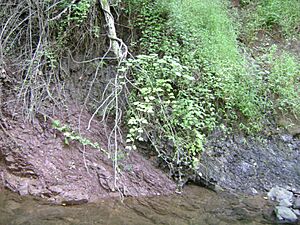Watchung Outliers facts for kids
The Watchung Outliers are a group of six small, separate hills and rocky areas. They are found in New York, New Jersey, and Pennsylvania. These hills are made of volcanic rock (from ancient lava flows) and sedimentary rock (layers of sand and mud).
Think of them as tiny, leftover pieces of the much larger Watchung Mountains. They formed from old lava flows that happened during the Triassic and Jurassic periods, millions of years ago. All six outliers are located along the western edge of the Newark Basin, near a big crack in the Earth's crust called the Ramapo Fault.
The six outliers, from north to south, are:
- Ladentown
- Union Hill
- New Germantown/Oldwick (which includes Round Top)
- Prospect Hill
- Sand Brook
- Jacksonwald
Contents
Ladentown Outlier: An Ancient Volcano's Remnant
The Ladentown Outlier is the most northern of these special hills. It's located near the towns of Haverstraw and Ramapo, New York. This outlier is about seven miles north of the main Watchung Mountains.
This whole area is made of volcanic rock, called Ladentown basalt. It stretches for about two miles long and one mile wide. Scientists first thought it was part of the nearby Palisades, another large rock formation. But now we know it's a separate, ancient lava flow.
New research suggests that Ladentown might have been the main spot where the lava for the Watchung Mountains first burst out of the ground! It's like the remains of an old "fissure volcano," where lava flowed out of a long crack in the Earth.
Union Hill: A Hill That's Mostly Gone
Union Hill is located near Suffern in Ramapo, New York. It's about halfway between the Ladentown Outlier and the main Watchung Mountains.
This hill was once about 150 feet tall. But a lot of it has been removed by quarrying, which is when rock is dug out for building materials. So, only the edges of the hill are left.
Union Hill is made of different layers of rock. The outer part is made of Orange Mountain Basalt. Inside that is a layer of sedimentary rock from the Feltville Formation. And in the very center, there was Preakness Mountain Basalt, which is the part that was mostly quarried away.
New Germantown Outlier: A Mini Mountain Range
The New Germantown Outlier (also called the Oldwick Outlier) is the first outlier you find south of the main Watchung Mountains. It's located in Tewksbury and Readington Township, New Jersey.
This outlier looks like a tiny version of the Watchung Mountains themselves!
- The eastern side has a horseshoe-shaped ridge made of Orange Mountain basalt. This rock is still being quarried today.
- West of this ridge is a valley with sedimentary rock layers, just like the valleys in the Watchung Mountains.
- In the middle of the horseshoe is a dome-shaped hill called Round Top. This hill is made of Preakness Mountain Basalt. It's like the "Second Watchung Mountain" of this small area.
The basalt rock here is estimated to be about 425 feet thick!
Prospect Hill: Small but Important
Prospect Hill is the smallest of the Watchung Outliers. It's located near Flemington and Raritan Township, New Jersey. It's only about a quarter-mile wide and less than half a mile long.
This hill is made of Orange Mountain Basalt. Scientists believe Prospect Hill is another place where the ancient lava, which formed the Palisades, found its way to the surface. It wasn't as big of an eruption as Ladentown, but it's still a key spot.
Sand Brook Outlier: A Twin to New Germantown
The Sand Brook Outlier is located in Delaware Township, New Jersey. It looks almost exactly like the New Germantown Outlier!
It has a low, horseshoe-shaped ridge of Orange Mountain Basalt on its eastern side. This ridge surrounds a belt of sedimentary rock from the Feltville Formation. In the very middle, there's a dome-like area that is likely Preakness Mountain Basalt, similar to Round Top in New Germantown. The basalt here is nearly 400 feet thick.
Jacksonwald Outlier: The Pennsylvania Outlier
The Jacksonwald Outlier is special because it's the only Watchung Outlier found in Pennsylvania. It's located in Exeter Township, over 60 miles southwest of the main Watchung Mountains.
Like Sand Brook and New Germantown, Jacksonwald has a low, horseshoe-shaped ridge of Orange Mountain Basalt. This ridge surrounds an area of sedimentary rock from the Feltville Formation. However, unlike the other two, Jacksonwald doesn't have a central dome of Preakness Mountain Basalt. The basalt here is over 325 feet thick.
An interesting feature of Jacksonwald is that it's surrounded by a ridge of a different type of rock called diabase on its eastern side. This diabase rock is thought to have pushed its way into the existing rock layers.


